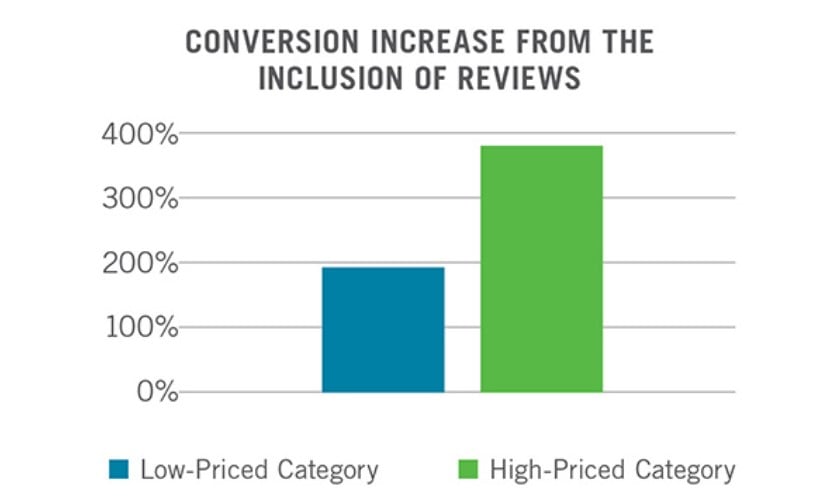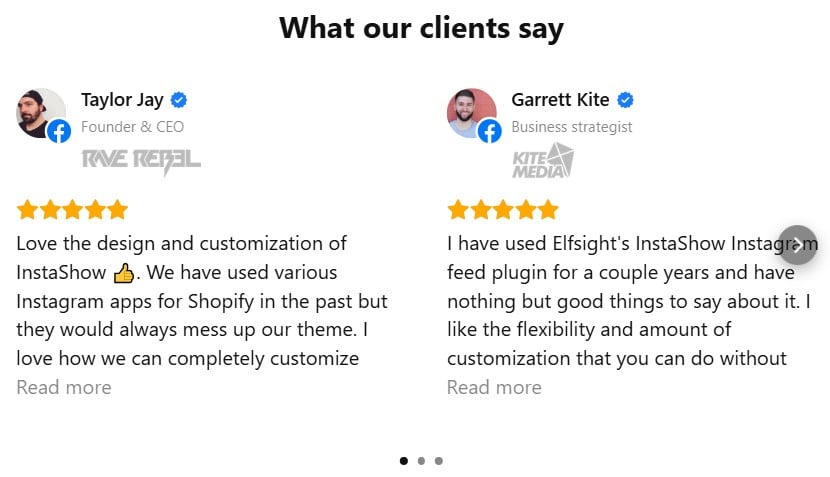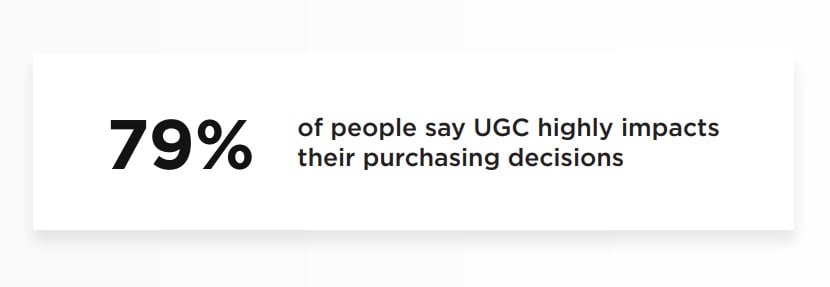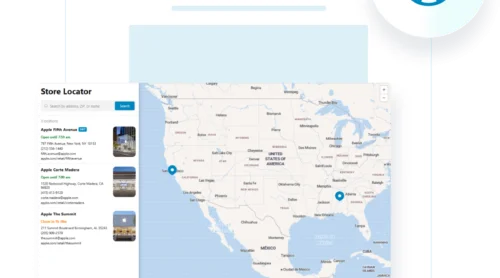What Is Social Proof?
Social proof is a psychological concept where people tend to follow the actions, behaviors, and decisions of others, especially in uncertain or unfamiliar situations. The concept is rooted in social psychology and plays a significant role in influencing the decision-making process.
On websites, social proof is a tool used to build trust and encourage conversions by showcasing the actions, opinions, or endorsements of others. This could include customer reviews, influencer recommendations, or even metrics like the number of users or purchases made.
Social proof is a cornerstone of marketing and advertising strategies, helping businesses connect with their audiences and establish credibility. For instance, social proof in advertising frequently uses customer stories or influencer testimonials to establish a brand’s reliability. Ecommerce social proof, such as showcasing recent sales notifications or aggregate product ratings, not only boosts conversions but also reinforces a sense of community and shared trust among potential customers. In the context of ecommerce, it’s essential for overcoming purchase hesitation and convincing visitors to take action.
Why Social Proof Matters
Social proof is one of the most powerful tools in your marketing toolkit. It taps into human psychology by showing potential customers that others trust and value your brand. When implemented effectively, social proof can transform how your audience perceives your business, helping you establish a reputation as a credible and trustworthy brand. Here’s why it’s an indispensable part of your strategy:
- Builds trust: When visitors see that others have had positive experiences with your brand, they’re more likely to trust your offerings.
- Increases conversions: Social proof reduces hesitation by providing reassurance and validation.
- Enhances credibility: Displays of popularity or endorsements add legitimacy to your offerings, making your brand more trustworthy.
Incorporating social proof isn’t just about displaying reviews or ratings – it’s about creating a compelling narrative that inspires confidence and encourages action.
Where Social Proof is Most Effective
To maximize the benefits of social proof, it’s crucial to know where to place it on your website. Strategic placement ensures that visitors encounter these trust-building elements exactly when they need reassurance, whether they’re learning about your brand or finalizing a purchase. Below are the areas where social proof can make the biggest impact:
| Homepage | Showcase your most compelling social proof elements, such as customer reviews or trust badges, to make a strong first impression. |
| Product Pages | Use customer reviews, ratings, and social media shares to validate purchasing decisions and highlight product benefits. |
| Checkout Pages | Display sales notifications, trust badges, or guarantees to ease last-minute doubts and encourage completion of the purchase process. |
| Landing Pages | Incorporate testimonials, case studies, or influencer endorsements to boost campaign performance and drive conversions. |
By thoughtfully placing social proof elements on these pages, you can significantly enhance user confidence and engagement, paving the way for better conversions, stronger brand loyalty, and sustained growth.
Examples of Social Proof for Websites
Social proof comes in many forms, each catering to different audiences and goals. Below, we’ve gathered 15 impactful social proof examples you can use on your website:
Customer Reviews and Ratings
Customer reviews and ratings are among the most effective and influential types of social proof. They provide potential buyers with genuine feedback from others who have already purchased your product or service. Highlight positive experiences and address any common concerns through these reviews. Displaying reviews on your website helps visitors make informed decisions and establishes a sense of reliability. Statistics underline the power of reviews: according to Spiegel Research, displaying reviews increases purchase likelihood by 190% for low-cost items and 380% for high-cost items. Potential buyers view reviews as trustworthy, especially when paired with a verified purchase tag. For insights on leveraging customer feedback effectively, check out this guide on adding customer reviews to your website.

By integrating tools like Elfsight’s All-in-One Reviews widget, you can effortlessly showcase customer feedback on your site. This widget allows you to import reviews from multiple platforms like Google, Facebook, or Yelp.
Try it out with the on-page editor to create a professional, user-friendly review section.
Testimonials
Testimonials are personal, heartfelt endorsements that emphasize specific benefits of your product or service. Unlike reviews, they are typically solicited from satisfied customers who agree to share their positive experiences publicly. Testimonials create an emotional connection with potential buyers, offering a glimpse into the real-life value of what you provide.
For instance, a customer might say, “Thanks to [Your Product], our team increased productivity by 50%!” Such personal narratives not only showcase unique benefits but also build a sense of trust and relatability. Research by BigCommerce reveals that 72% of consumers feel positive testimonials enhance their trust in a business.Display testimonials strategically on your homepage, product pages, or email campaigns to maximize their impact. Pair these quotes with photos, job titles, or company names to add authenticity. Featuring testimonials from high-profile clients or well-known organizations can also elevate your brand’s prestige. Tools like the Testimonial Slider widget make it easy to present testimonials in an engaging and interactive format, boosting both credibility and visibility.

Case Studies
Case studies go beyond testimonials, offering a comprehensive look at how your product or service has addressed specific customer challenges. They provide a structured narrative – detailing the client’s pain points, your solution, and the results achieved – serving as a powerful demonstration of your expertise.
For example, a case study might reveal how your product helped a mid-sized company increase online sales by 30% within three months. Such insights resonate particularly well with B2B audiences, as they offer tangible proof of success. 65% of marketers consider case studies and success stories to be the most effective content format and drive the biggest value.
Make your case studies accessible through your website, blog posts, or downloadable PDFs. Enhance their appeal with visuals such as before-and-after data charts, client testimonials, or images of your product in action. These elements make the story relatable and easier for your audience to visualize, increasing their engagement and trust in your solutions. You can also explore review aggregators to present multiple reviews and case studies more efficiently, boosting audience trust.
Influencer Endorsements
Collaborating with influencers in your industry can significantly boost your brand’s visibility and credibility. Influencers have loyal audiences who trust their recommendations, making their endorsements an effective form of social proof. Sprout Social highlights that 64% of consumers trust influencer recommendations, often leading to increased leads and sales.
So, when choosing influencers, focus on those whose followers align with your target audience. For instance, a fitness influencer endorsing your health supplement will likely drive more engagement than a general lifestyle influencer. Feature these partnerships on your website through quotes, images, or videos. Many influencers also share content about your brand on social media, further amplifying your reach.
User-Generated Content (UGC)
User-generated content, such as photos, videos, or testimonials from your customers, provides authentic social proof. It shows your product in real-world use, making it relatable to potential buyers. A Stackla study found that 79% of consumers believe UGC significantly influences their purchase decisions.

Encourage customers to share their experiences by creating branded hashtags or running contests on social media. For example, a fashion brand could invite users to share photos of themselves wearing their outfits, which can then be featured on the website in a gallery or testimonial section.
UGC not only validates your brand but also fosters a sense of community. Recognizing and celebrating customer contributions strengthens loyalty and shows you value their voices. Use this content to humanize your brand and create deeper engagement with your audience.
Trust Badges
Trust badges are visual indicators that reassure visitors about the safety and reliability of your website. Common examples include “Secure Payment,” “Verified by Visa,” or “100% Money-Back Guarantee.” These symbols are particularly important on ecommerce websites, where customers need assurance before entering payment details.
Place trust badges strategically on your site, such as the checkout page, product pages, or landing pages. Align with reputable organizations for SSL certifications or payment security to enhance their impact. By reducing hesitation, trust badges can significantly lower cart abandonment rates and drive sales.
Subscriber Counts
Sharing your subscriber count is a simple yet effective way to showcase popularity and trust. When visitors see that thousands of others have signed up for your newsletter or service, they’re more likely to follow suit. Highlight these numbers prominently on your signup forms or landing pages with phrases like “Join 20,000+ satisfied subscribers.” Using a Number Counter widget can make this statistic even more engaging. As the number ticks up in real-time, it creates a sense of excitement and urgency, encouraging visitors to take action. Make it even more compelling by emphasizing the benefits of subscribing, such as exclusive content, discounts, or early access to new products.
Social Media Followers
Social media follower counts and engagement metrics, such as likes or shares, are strong indicators of your brand’s popularity. Displaying these numbers on your website adds credibility and encourages visitors to explore your social media presence. For example, you can embed a live Instagram Feed showcasing your posts or highlight the number of shares a blog post has received. This form of social proof not only validates your brand but also drives traffic to your social channels, creating more opportunities for engagement.
Sales Notifications
Real-time sales notifications are an excellent way to create urgency and build trust. Tools like Elfsight Sales Notification display recent purchases on your site, showing visitors that others are actively buying your products. This dynamic feature fosters a sense of community and encourages hesitant buyers to make a purchase. For instance, seeing a notification like “John from New York just purchased this item” can reassure visitors of your product’s popularity. The interactive nature of these notifications adds vibrancy to your site and boosts conversions.

Celebrity Endorsements
Endorsements from well-known personalities lend prestige and aspirational value to your brand. Whether it’s a celebrity, athlete, or industry leader, their support can significantly impact consumer perception.
To maximize the impact, prominently feature these endorsements on your website using high-quality photos, engaging quotes, or even video testimonials. For example, a video of a celebrity using your product in their daily routine can create a sense of authenticity and relatability. However, authenticity is key. Ensure that the personalities you collaborate with align with your brand values and genuinely believe in your offering. This alignment will resonate with audiences, making the endorsement feel organic rather than transactional.
Celebrity endorsements don’t have to break the bank — consider micro-influencers or local figures with a dedicated following. These endorsements can deliver the same sense of trust, tailored to your niche audience.
Media Mentions
There’s a reason brands proudly showcase logos and quotes from prominent publications—it’s a powerful form of validation. When potential customers see your business featured in trusted media outlets, it reinforces the idea that your brand is worth paying attention to. For instance, a mention in Forbes or TechCrunch can elevate your credibility, while an article in a niche trade magazine highlights your expertise in a specific field.
Capitalize on these mentions by creating a dedicated “As Seen In” section on your homepage or integrating snippets into your testimonials. Accompany these media mentions with visually appealing layouts, such as a carousel of publication logos or clickable links to full articles. Additionally, share these mentions on your social media channels to extend their reach.
Media coverage isn’t just for large corporations. A startup’s feature in a local newspaper or an industry blog can have a significant impact. These mentions serve as social proof, reassuring potential customers that your brand is both visible and reputable.
Partnership Logos
The phrase “You’re judged by the company you keep” holds true in business. Displaying the logos of your high-profile partners or collaborators is an effective way to establish trust and credibility. For example, if your company has collaborated with Fortune 500 brands or globally recognized organizations, showcasing their logos on your website signals to visitors that your business is reliable and capable of handling significant projects.
Position these logos strategically — on your homepage, “About Us” page, or even product pages. Pair them with a brief explanation of the partnership to add context. For instance, you could write, “In partnership with [Company Name] to deliver innovative solutions to over 1 million users.”
To make your partnership logos even more visually appealing and interactive, you can use a Logo Showcase widget. This tool allows you to display logos in a variety of layouts, with hover effects, and even animations. By using a logo showcase widget, you can create a more engaging and professional display of your partnerships.
Even small businesses can benefit from showcasing partnerships. Highlighting collaborations with local businesses, charities, or community organizations demonstrates your engagement and trustworthiness on a more personal level.

Customer Photos
Nothing captures authenticity like real customers enjoying your product in their everyday lives. Sharing customer photos adds a personal and relatable touch to your website, bridging the gap between your brand and potential buyers. For instance, a photo of a family using your outdoor gear during a hiking trip can inspire confidence and trust in your product’s quality.
Encourage customers to share their experiences by creating a branded hashtag or running a social media contest. Feature these photos prominently on your site, perhaps as a gallery on your homepage or as part of your testimonials section. You could even create a “Customer Spotlight” segment, where you share stories and images of your most loyal customers.
Using a Photo Gallery widget can enhance the visual appeal of your customer photos. By using a photo gallery, you can create a more engaging and professional display of your customer photos.
Using authentic visuals not only validates your product but also fosters a sense of community. Unlike polished stock images, real customer photos show your product in action, making it easier for visitors to envision themselves using it.
Star Ratings on Search Results
Have you ever chosen a product simply because its Google search listing showed a stellar 4.8-star rating? You’re not alone. Star ratings displayed in search results are an instant form of social proof, providing users with a snapshot of your business’s reputation. According to a BrightLocal survey, 87% of consumers read online reviews for local businesses, and star ratings play a pivotal role in their decision-making process.
To implement this feature, utilize structured data (schema markup) on your website. This technical step allows search engines to display your ratings directly in search results, increasing your click-through rate (CTR) and making your listing stand out. Find out more about how to get a star rating in Google search results in our article.
Pair this strategy with a consistent effort to gather reviews. Encourage satisfied customers to leave feedback on platforms like Google, Yelp, or Trustpilot. The more positive reviews you accumulate, the more your star rating reflects the quality of your product or service.
Limited-Time Sales Alerts
Urgency is one of the most effective motivators in consumer behavior, and limited-time offers capitalize on this psychological trigger. Imagine visiting a website and seeing a banner that reads, “Flash Sale: 50% off ends in 2 hours!” The ticking clock creates a fear of missing out (FOMO), prompting visitors to act quickly.
Use bold, attention-grabbing notifications to highlight these offers on your website. For example, a countdown timer can visually reinforce the limited availability of the deal. Pair this with phrases like “Only 5 items left in stock” to add an extra layer of urgency.
Limited-time offers aren’t just for discounts. Announce limited availability of new products, exclusive content, or early-bird registrations for an event. These strategies not only drive immediate action but also make customers feel like they’re part of something exclusive.

These examples illustrate the versatility of social proof and its ability to engage audiences across various contexts. By implementing a mix of these strategies, you can cater to different user preferences and enhance trust and conversions on your website.
Best Practices for Using Social Proof
While examples provide inspiration, following best practices ensures your social proof is effective. Here are actionable tips on how to use social proof most effectively:
- Highlight relevant Social Proof
Ensure the examples you showcase resonate deeply with your target audience. For instance, ecommerce sites should prioritize showcasing customer reviews, star ratings, and real-time sales notifications to build trust and urgency. For service-based websites, featuring testimonials and success stories can be more impactful. Tailoring social proof types to your audience ensures higher relevance and effectiveness. - Keep it authentic
Genuine feedback matters. Customers can detect fake reviews, which can harm credibility. Encourage real testimonials by reaching out to satisfied customers, offering post-purchase surveys, or incentivizing honest reviews. Highlight verified buyer badges to further validate authenticity, a practice especially crucial in ecommerce social proof marketing. - Leverage visual content
Visual content is key in creating engaging and trustworthy social proof. Use photos of happy customers, product demonstration videos, or user-generated content (UGC). Infographics summarizing review statistics or feedback trends can also be highly effective in social proof advertising. - Optimize placement
Positioning social proof strategically is vital. For example:
Product pages may include customer ratings and reviews directly under product descriptions.
Checkout pages are good for displaying real-time purchase notifications and trust badges to reduce cart abandonment.
On landing pages use impactful testimonials and partner logos to drive conversions.
Homepages can showcase top-performing reviews or a live sales feed to make an immediate impression.
Thoughtful placement ensures your audience sees the right proof at the right time. - Update regularly
Social proof is most effective when it feels current. Regularly refresh testimonials, update user reviews, and feature recent customer achievements to maintain relevance. Highlight new collaborations or recent awards to show continued success. Staying updated demonstrates to your audience that your business remains active, credible, and trustworthy. Leverage advanced social proof tools for seamless integration.
Widgets like the Elfsight All-in-One Reviews consolidate reviews from multiple platforms, saving time and amplifying trust. Similarly, the Sales Notification Widget automates real-time activity displays, enhancing user experience. Utilizing these tools streamlines your social proof strategy, ensuring efficiency and maximum impact.
How to Collect and Add Social Proof to Your Website
Adding social proof to your website is easier than you think. However, it requires a strategic approach to ensure effectiveness. Here’s a step-by-step guide:
- Choose the right type. Identify the most relevant social proof for your audience (e.g., reviews for ecommerce, testimonials for services).
- Gather content. Start by reaching out to satisfied customers for testimonials or reviews through personalized emails or post-purchase surveys.
Alternatively, encourage user-generated content by hosting social media contests or asking users to share their product experiences. - Use tools. Leverage tools like Google Reviews or Yelp to gather authentic feedback
Once collected, embed these testimonials, reviews, or user-generated visuals directly onto relevant pages using widgets like the Elfsight All-in-One Reviews. Make sure to highlight diverse types of social proof across the homepage, product pages, and checkout sections to optimize their impact. - Test and optimize. Regularly analyze performance to ensure your social proof is delivering results. And keep refreshing your social proof content to ensure it remains current and credible.
Conclusion
Incorporating social proof is essential for any website aiming to build trust, engage visitors, and drive conversions. Whether through customer reviews, testimonials, user-generated content, or sales notifications, social proof serves as a powerful tool to influence potential buyers and reinforce your brand’s credibility.
A well-executed social proof marketing strategy not only enhances your website’s appeal but also establishes a deeper connection with your audience. By using a versatile social proof widget like Elfsight’s All-in-One Reviews, you can effortlessly showcase authentic feedback from satisfied customers, display recent sales, or highlight influential endorsements – all of which create a strong impression of reliability and popularity.
Ready to elevate your website? Explore the intuitive editor of Elfsight’s All-in-One Reviews widget and experience firsthand how impactful social proof marketing can be for your business success. It’s time to turn visitor curiosity into loyal customer engagement!
Need More Info?
We hope this guide has clarified how to showcase social proof effectively on your website. If you have additional questions or need further assistance, we’re here to help. At Elfsight, our mission is to provide user-friendly, no-code widgets designed to elevate your website and meet your business goals.
Join our vibrant Community, where users exchange insights, tips, and success stories to inspire and support each other. Got an idea for a new feature or improvement? Share it on our Wishlist – your feedback helps us innovate and create tools that truly make a difference.
Visit our Help Center to learn more about Elfsight’s widgets, including such social proof tools as the All-in-One Reviews and Sales Notification widgets, and how they can enhance your website’s performance.
By implementing the right widgets, you can build trust, engage your audience, and drive measurable results for your business!


![Social Proof on a Website [15+ Examples & Tips]](https://elfsight.com/wp-content/uploads/2024/12/social-proof-on-website-featured-image.png)




